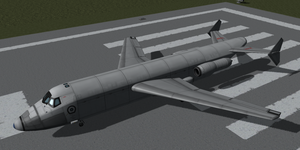Difference between revisions of "Mallard"
(→Craft Description: altitude/range comment) |
|||
| (3 intermediate revisions by one other user not shown) | |||
| Line 1: | Line 1: | ||
| − | |||
| − | |||
The '''Mallard''' is a heavy cargo seaplane. The airframe bears a close resemblance to the [https://en.wikipedia.org/wiki/Antonov_An-225_Mriya Antonov An-225 Mriya] but the engines are mounted on the rear of the fuselage in a similar way to the [https://en.wikipedia.org/wiki/Beriev_Be-200 Beriev Be-200.] It is the second-largest stock cargo aircraft in the game, the [[Stearwing A300]] having a substantially larger wingspan. | The '''Mallard''' is a heavy cargo seaplane. The airframe bears a close resemblance to the [https://en.wikipedia.org/wiki/Antonov_An-225_Mriya Antonov An-225 Mriya] but the engines are mounted on the rear of the fuselage in a similar way to the [https://en.wikipedia.org/wiki/Beriev_Be-200 Beriev Be-200.] It is the second-largest stock cargo aircraft in the game, the [[Stearwing A300]] having a substantially larger wingspan. | ||
| + | [[File:Mallard.png|thumb|The mallard's thumb in the stock craft selector.]] | ||
[[File:Mallard on the runway.png|thumbnail|right|The Mallard on the runway ([[1.0.5]])]] | [[File:Mallard on the runway.png|thumbnail|right|The Mallard on the runway ([[1.0.5]])]] | ||
| Line 17: | Line 16: | ||
9: Extend flaps<br /> | 9: Extend flaps<br /> | ||
0: Retract flaps<br /> | 0: Retract flaps<br /> | ||
| + | |||
| + | == Possible Improvements == | ||
| + | The stock Mallard is mostly stable and easy to fly, but it may perhaps be improved a little further. | ||
| + | * Decrease the fuel flow priority of the [[Engine Nacelle]]s to use fuel from the other tanks first. This is because the weight of the fuel in the (rear-mounted) engine nacelles balances the weight of the cockpit. As fuel drains from the nacelles, the center of mass moves forward. This makes it harder to splash down without breaking the fragile nose cone. Experienced pilots may not need to do this. Don't change the flow priority of the [[Mk1 Liquid Fuel Fuselage]]s or the center of mass will move too far back. | ||
== See also == | == See also == | ||
Latest revision as of 21:49, 20 June 2022
The Mallard is a heavy cargo seaplane. The airframe bears a close resemblance to the Antonov An-225 Mriya but the engines are mounted on the rear of the fuselage in a similar way to the Beriev Be-200. It is the second-largest stock cargo aircraft in the game, the Stearwing A300 having a substantially larger wingspan.

Craft Description
| “ | The Mallard is a large seaplane with twin high-efficiency turbofans mounted high on the fuselage to clear the spray. It is somewhat slow but very steady in flight. A full suite of flaps on the trailing edges of the main wings give it exceptional low-speed lift, and small hydroplane steps mounted on each side of the fuselage bottom help lift it out of the water (lowering water drag) during takeoff runs. Its entire fuselage, absent the cockpit forward, is one long cargobay, with a ramp at the tail end. This allows rovers (and boats) to come aboard or leave while the Mallard is landed. It's a bit low on fuel, so you might consider adding some to the cargo bay for long flights, or make them at high altitude. — Squad |
” |
High altitude certainly helps. With no cargo, if you set the throttle to maximum and let it find its natural altitude, it appears to have almost enough fuel to circumnavigate Kerbin. (Testing this would take about 4 hours.)
Action Groups
3: Toggle ladders
4: Toggle cargo bay doors
5: Toggle cargo bay rear ramp
6: Toggle jet engine reverse thrust
9: Extend flaps
0: Retract flaps
Possible Improvements
The stock Mallard is mostly stable and easy to fly, but it may perhaps be improved a little further.
- Decrease the fuel flow priority of the Engine Nacelles to use fuel from the other tanks first. This is because the weight of the fuel in the (rear-mounted) engine nacelles balances the weight of the cockpit. As fuel drains from the nacelles, the center of mass moves forward. This makes it harder to splash down without breaking the fragile nose cone. Experienced pilots may not need to do this. Don't change the flow priority of the Mk1 Liquid Fuel Fuselages or the center of mass will move too far back.
